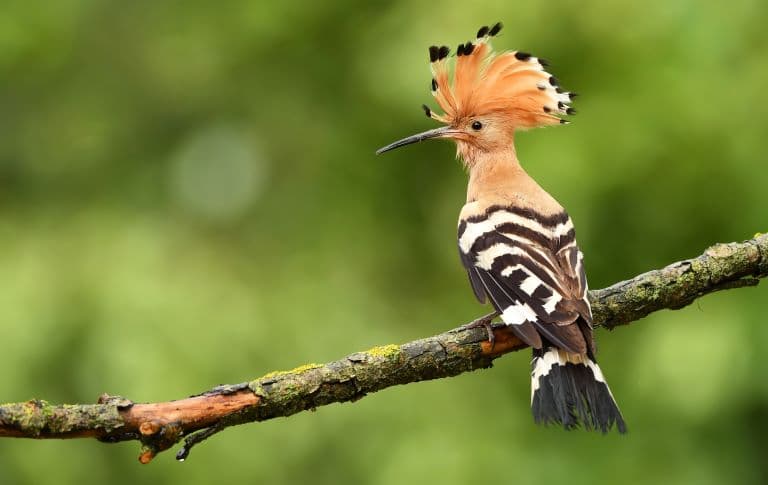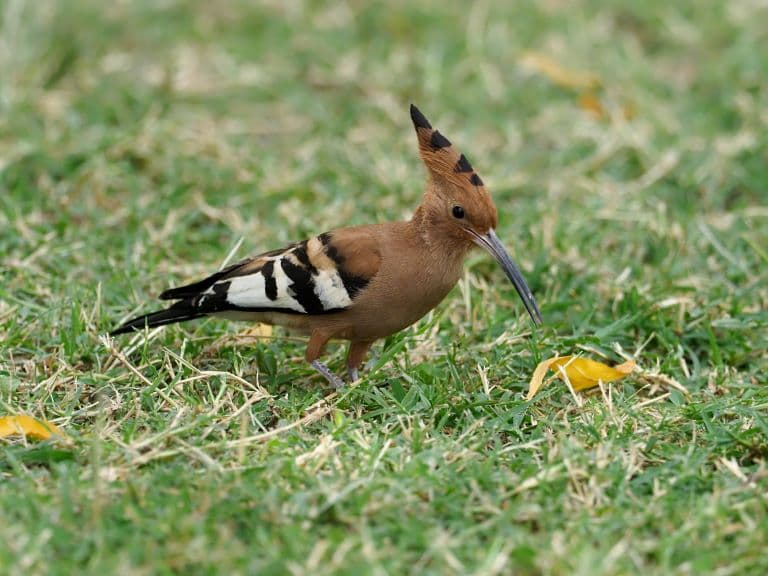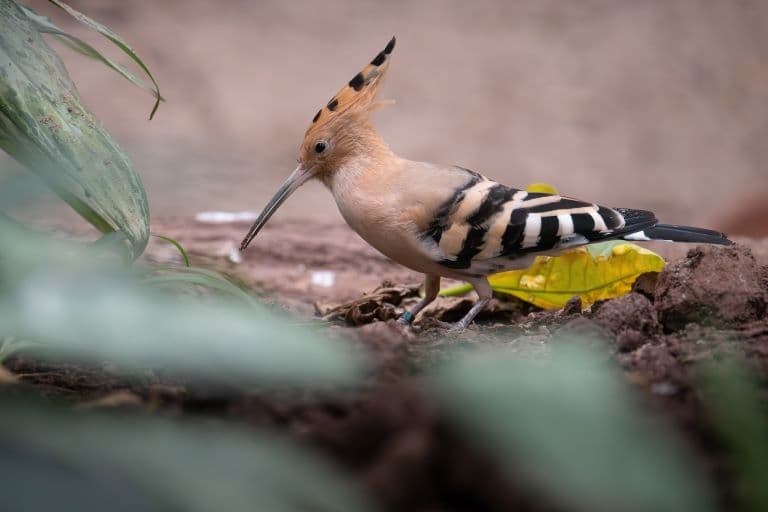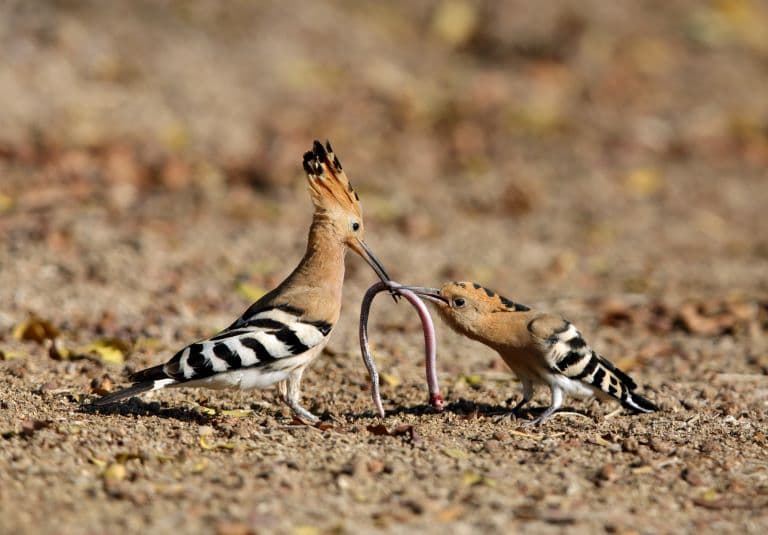Hoopoe Profile
One of the most exciting things about visiting a new place for animal lovers is exploring all the new creatures from distant lands. Birds are especially popular because they can be so diverse and so different, depending on which continent you visit.
But almost wherever you go (as long as it’s outside of the Americas), there always seems to be a Hoopoe.

Hoopoe Facts Overview
| Habitat: | Grasslands, open woodlands |
| Location: | Widespread: mainly Africa, Asia, Europe |
| Lifespan: | 10 years |
| Size: | Up to 32 cm (12.6 in) long |
| Weight: | Up to 91 g (3.2 oz) |
| Colour: | Orange-brown, black and white wings |
| Diet: | Mostly insects |
| Predators: | Monitor lizards, jackals, foxes, rats, cats, snakes, humans |
| Top Speed: | Unknown |
| No. of Species: | 1, 2 or 3 |
| Conservation Status: | Vulnerable (Eurasian hoopoe) Least Concern (Madagascan hoopoe) |
Hoopoes are in the hornbill order, though quite a bit smaller than some of the heavyweights found in there. Like hornbills though, they have long and powerful beaks for their size and use them to probe about in anything they think might contain insects.
These are incredibly widespread birds, spanning most continents, but they aren’t immune to decline, and the Eurasian species is now listed as vulnerable.
Interesting Hoopoe Facts
1. They’re Hornbills
The name of this bird comes from its call, which is similar in sound. As usual, there’s great debate over which species they closest relate to, but the current understanding is that hoopoes and their relatives the wood hoopoes, sit in the order of Bucerotiformes, which is also where Zazu from The Lion King is placed.

2. They’re everywhere!
Hoopoes are incredibly widespread across Africa, Asia and Europe.
To tell them apart by their range gets very complicated. You have the African species, U. Africana, which occupies a range spanning more or less the entirety of Africa below the equator.
But then you have the Eurasian species, U. epops, which also resides in Asia and Africa, just above the range of the African species. But this one also migrates, so spends a lot of time in Eurasia (hence the name), but can also be found in the Middle East and Siberia.
This species also makes it to Britain on occasion, which is about the most exciting thing to ever happen in the life of a British birdwatcher.
Finally, you have a Madagascan species, U. marginata supposedly distinct again from the African species, which appears to be limited to the island and is a little bigger than the other two.
So, it’s really only the Americas and Australia that are missing out, but in 1975, one was found among drift logs and debris in Alaska, and in 2011, hoopoes were spotted alive and well in Australia’s Northern Territory. 1

3. Nobody can agree on the number of species
Until fairly recently, all three were grouped as a single species, which many still believe is the sensible way to go about it. Others keep the African and Asian birds as a single species and differentiate those from the Madagascan ones.
So currently, there are between one and three species of hoopoe, distributed all over Africa, Asia and Europe, with a few in North America and Australia. We’re just waiting for the twitchers in Antarctica to find one.
But these are all the extant species. There was once a giant, flightless hoopoe that nobody is talking about! 2
4. Saint Helena Hoopoe
The smaller the landmass, the faster humans wipe all the animal species from it, and the island of Saint Helena is a fantastically small landmass at around 16 by 8 km, so it’s no wonder that within 50 years of its discovery, people stopped seeing its endemic hoopoe species around.
This large species would have been almost twice the size of today’s examples and was thought to be flightless.
On the same island, there is a species of giant earwig, which is thought to have kept the large birds well-fed until their extinction, which came along with numerous other unique, likely flightless bird species on the island. 3
5. They have strong beaks
While they are capable of catching insects on the wing, hoopoes feed mostly in the ground and make great use of their long, curved beaks to do so.
This beak is great for probing and will be used to investigate leaf piles, loose dirt, herbivore dung, or anything that might be a good place to find bugs. Interestingly, when probing the ground, the hoopoe uses a strange technique sometimes called “gaping”, which makes use of their powerful beak muscles to open the bill under the soil, against the resistance of the earth.

6. They starve their own kids
It’s tempting to judge the reproductive strategies of birds, and the subsequent parenting skills (or, lack thereof), but these birds survived the extinction of 75% of all plant and animal species, including every other lineage of dinosaurs, so they know what they’re doing.
Hoopoes usually lay two or more eggs, asynchronously, and the amount of food will determine whether they all make it. Through a process known as “selective starvation”, the latest chick to emerge will be the least likely to make it, and the number of successful fledglings will depend on how much food there is.
This is called a “brood reduction strategy” and is a way of hedging your bets. If the season is good and productive, you have a bunch of healthy chicks. If food is scarce, feed only the strongest ones and let the newborns starve.
Birds are brutal. 4
7. They’re in decline
While they’re still everywhere, there are certainly fewer of them than there have been in the past. Particularly the Eurasian species, which is hunted in the Mediterranean, Kuwait, and parts of Southeast Asia.
As mentioned before, food availability plays a significant role in breeding success, and with habitat reduction, this food is less available. Equally important is the availability of the nesting sites, which is declining in many parts of the world for most bird species.
The problem for the hoopoe in particular is that these two habitats are different.

8. They need two habitats
One of the issues for this bird is that its nesting and foraging sites are two different environments.
The hoopoe loves to nest in deciduous woodland, but it forages in scrubby, short grasses. This makes habitat diversity the key to its success, which is one of the major reasons the Eurasian species is in decline.
While it’s hard to find good single habitats, it’s even harder to find specific combinations of habitats, which unfortunately compounds the issue for this species. 5
Hoopoe Fact-File Summary
Scientific Classification
| Kingdom: | Animalia |
| Phylum: | Chordata |
| Class: | Aves |
| Order: | Bucerotiformes |
| Family: | Upupidae |
| Genus: | Upupa |
Fact Sources & References
- atulloch(2014), “Eurasian Hoopoe in the Northern Territory”, eBird Australia.
- Author Name (Year), “The Far End of the Probability Curve: A Hoopoe in Alaska”, Wickersham’s Conscience.
- “Saint Helena Hoopoe”, IUCN Red List.
- M. Martín-Vivaldi (2010), “Determinants of reproductive success in the Hoopoe Upupa epops, a hole-nesting non-passerine bird with asynchronous hatching”, Taylor & Francis Online.
- Luc Barbaro (2007), “Home Plantation Forests and Biodiversity: Oxymoron or Opportunity? Chapter Multi-scale habitat selection and foraging ecology of the eurasian hoopoe (Upupa epops) in pine plantations”, Springer Link.
